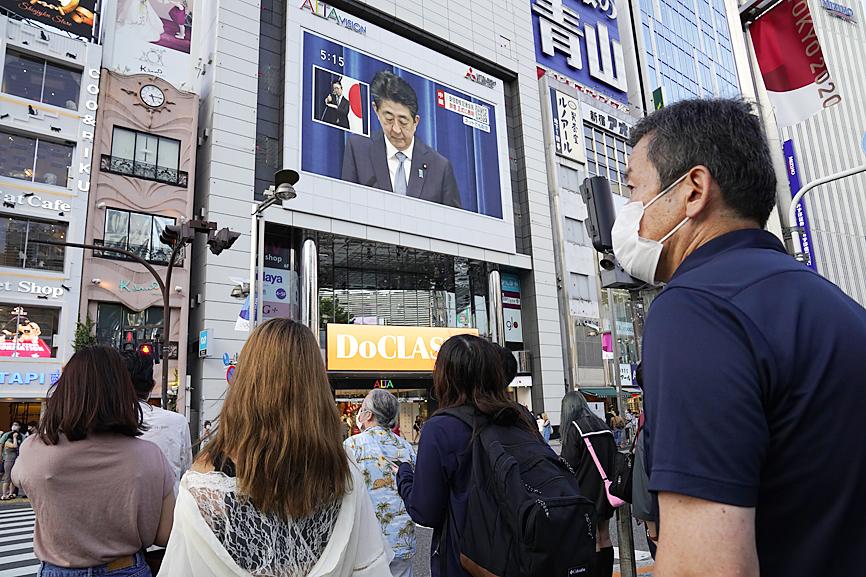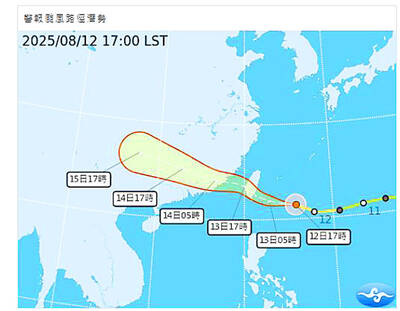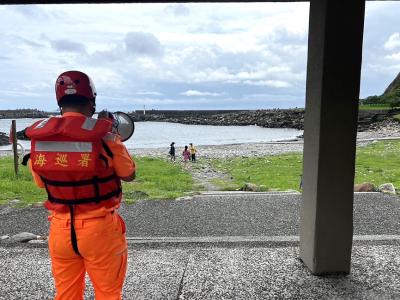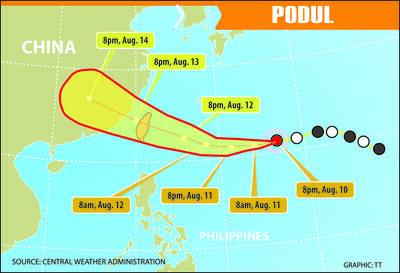The race to succeed Japanese Prime Minister Shinzo Abe started informally yesterday, with several contenders announcing their plans to stand, a day after Japan’s longest-serving leader announced his resignation.
Abe said he was experiencing a recurrence of ulcerative colitis, the condition that forced him to cut short his first term in office, but that he would stay on until his successor is decided.
Exactly how the process would unfold was still unclear, with local media reporting that several options were being considered.

Photo: EPA-EFE
Abe’s ruling Liberal Democratic Party (LDP) could opt for a more traditional leadership election, involving lawmakers but also members of the party nationwide.
The LDP would choose Abe’s successor on about Sept. 15, Kyodo news agency reported.
However, the urgency of the situation, as well as the constraints imposed by the COVID-19 pandemic, could see the party instead opt to poll only its lawmakers and regional representatives — a faster process.
A few would-be candidates have thrown their hats into the ring, including party policy chief Fumio Kishida, a mild-mannered former minister of foreign affairs considered Abe’s personal choice for successor, and former minister of defense Shigeru Ishiba, who is seen as more popular with voters, but commands less party support than some other candidates.
Japanese Minister of Finance Taro Aso, himself a former prime minister and long considered a likely successor to Abe, has announced that he would not stand.
Other possible candidates include powerful Japanese Chief Cabinet Secretary Yoshihide Suga, viewed by many as a frontrunner, and Japanese Minister of Defense Taro Kono, a social-media-savvy former foreign minister who is seen as something of a long shot.
One woman is among those expected to stand so far: Seiko Noda, a former Cabinet minister whose chances are thought to be slim.
Whoever comes out on top, little major shift in policy is expected, analysts have said.
“Key policies — diplomacy and economic measures — won’t be changed drastically,” Shinichi Nishikawa, a professor of political science at Meiji University in Tokyo, told reporters.
“His successor could be a caretaker,” Nishikawa added, given that the LDP is to hold another leadership election in September next year, with general elections likely the following month.
Additional reporting by Reuters

GET TO SAFETY: Authorities were scrambling to evacuate nearly 700 people in Hualien County to prepare for overflow from a natural dam formed by a previous typhoon Typhoon Podul yesterday intensified and accelerated as it neared Taiwan, with the impact expected to be felt overnight, the Central Weather Administration (CWA) said, while the Directorate-General of Personnel Administration announced that schools and government offices in most areas of southern and eastern Taiwan would be closed today. The affected regions are Tainan, Kaohsiung and Chiayi City, and Yunlin, Chiayi, Pingtung, Hualien and Taitung counties, as well as the outlying Penghu County. As of 10pm last night, the storm was about 370km east-southeast of Taitung County, moving west-northwest at 27kph, CWA data showed. With a radius of 120km, Podul is carrying maximum sustained

Tropical Storm Podul strengthened into a typhoon at 8pm yesterday, the Central Weather Administration (CWA) said, with a sea warning to be issued late last night or early this morning. As of 8pm, the typhoon was 1,020km east of Oluanpi (鵝鑾鼻), Taiwan’s southernmost tip, moving west at 23kph. The storm carried maximum sustained winds of 119kph and gusts reaching 155kph, the CWA said. Based on the tropical storm’s trajectory, a land warning could be issued any time from midday today, it added. CWA forecaster Chang Chun-yao (張竣堯) said Podul is a fast-moving storm that is forecast to bring its heaviest rainfall and strongest

TRAJECTORY: The severe tropical storm is predicted to be closest to Taiwan on Wednesday and Thursday, and would influence the nation to varying degrees, a forecaster said The Central Weather Administration (CWA) yesterday said it would likely issue a sea warning for Tropical Storm Podul tomorrow morning and a land warning that evening at the earliest. CWA forecaster Lin Ting-yi (林定宜) said the severe tropical storm is predicted to be closest to Taiwan on Wednesday and Thursday. As of 2pm yesterday, the storm was moving west at 21kph and packing sustained winds of 108kph and gusts of up to 136.8kph, the CWA said. Lin said that the tropical storm was about 1,710km east of Oluanpi (鵝鑾鼻), Taiwan’s southernmost tip, with two possible trajectories over the next one

TALKS CONTINUE: Although an agreement has not been reached with Washington, lowering the tariff from 32 percent to 20 percent is still progress, the vice premier said Taiwan would strive for a better US tariff rate in negotiations, with the goal being not just lowering the current 20-percent tariff rate, but also securing an exemption from tariff stacking, Vice Premier Cheng Li-chiun (鄭麗君) said yesterday. Cheng made the remarks at a news conference at the Executive Yuan explaining the new US tariffs and the government’s plans for supporting affected industries. US President Donald Trump on July 31 announced a new tariff rate of 20 percent on Taiwan’s exports to the US starting on Thursday last week, and the Office of Trade Negotiations on Friday confirmed that it